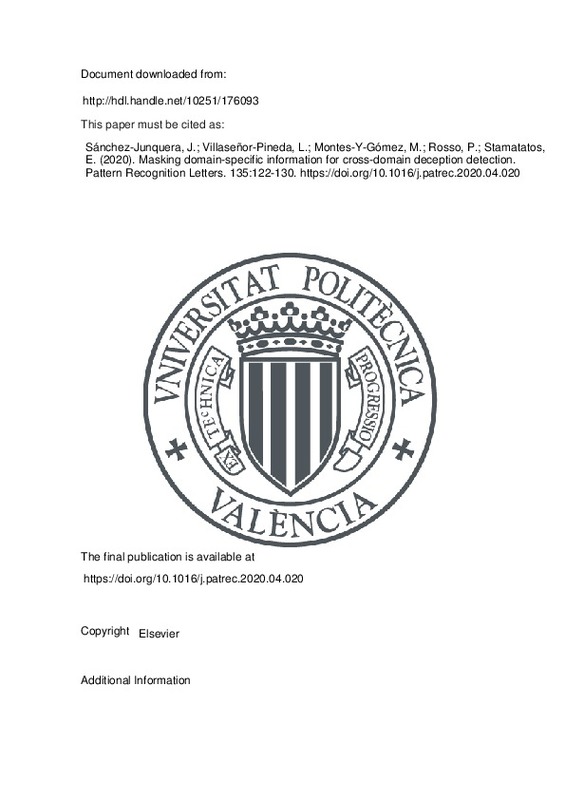JavaScript is disabled for your browser. Some features of this site may not work without it.
Buscar en RiuNet
Listar
Mi cuenta
Estadísticas
Ayuda RiuNet
Admin. UPV
Masking domain-specific information for cross-domain deception detection
Mostrar el registro sencillo del ítem
Ficheros en el ítem
| dc.contributor.author | Sánchez-Junquera, Javier
|
es_ES |
| dc.contributor.author | Villaseñor-Pineda, Luis
|
es_ES |
| dc.contributor.author | Montes-y-Gómez, Manuel
|
es_ES |
| dc.contributor.author | Rosso, Paolo
|
es_ES |
| dc.contributor.author | Stamatatos, Efstathios
|
es_ES |
| dc.date.accessioned | 2021-11-05T12:27:29Z | |
| dc.date.available | 2021-11-05T12:27:29Z | |
| dc.date.issued | 2020-07 | es_ES |
| dc.identifier.issn | 0167-8655 | es_ES |
| dc.identifier.uri | http://hdl.handle.net/10251/176093 | |
| dc.description.abstract | [EN] The facilities provided by social media and computer-mediated communication make easy the dissemination of deceptive behavior, after which different entities or people could be affected. The deception detection by supervised learning has been widely studied; however, the scenario in which there is one domain of interest and the labeled data is in another domain has received poor attention. This paper presents, to our knowledge, the first domain adaptation approach for cross-domain deception detection in texts. Our proposal consists in modifying original texts from the source and target domains in a form in which common content and style information is maintained, but domain-specific information is masked. In order to adequately select domain-specific terms to be masked, the proposed method uses unlabeled instances from both domains. Our experiments demonstrate that the masking technique is a good idea for detecting deception in cross-domain scenarios; and the performance could be further improved if unlabeled information from the target domain is considered. | es_ES |
| dc.description.sponsorship | The work of Javier Sanchez-Junquera and Paolo Rosso was funded by the MISMIS-FAKEnHATE Spanish MICINN research project (PGC2018-096212-B-C31). This work was parrtially supported also by CONACyT under grants CB-2015-01-257383, the Thematic Networks program, and the scholarship CONACyT-Mexico 613411. | es_ES |
| dc.language | Inglés | es_ES |
| dc.publisher | Elsevier | es_ES |
| dc.relation.ispartof | Pattern Recognition Letters | es_ES |
| dc.rights | Reconocimiento - No comercial - Sin obra derivada (by-nc-nd) | es_ES |
| dc.subject | Deception detection | es_ES |
| dc.subject | Domain adaptation | es_ES |
| dc.subject | Masking information | es_ES |
| dc.subject.classification | LENGUAJES Y SISTEMAS INFORMATICOS | es_ES |
| dc.title | Masking domain-specific information for cross-domain deception detection | es_ES |
| dc.type | Artículo | es_ES |
| dc.identifier.doi | 10.1016/j.patrec.2020.04.020 | es_ES |
| dc.relation.projectID | info:eu-repo/grantAgreement/CONACYT//613411/ | es_ES |
| dc.relation.projectID | info:eu-repo/grantAgreement/CONACYT//CB-2015-01-257383/ | es_ES |
| dc.relation.projectID | info:eu-repo/grantAgreement/AEI//PGC2018-096212-B-C31-AR//DESINFORMACION Y AGRESIVIDAD EN SOCIAL MEDIA: AGREGANDO INFORMACION Y ANALIZANDO EL LENGUAJE./ | es_ES |
| dc.rights.accessRights | Abierto | es_ES |
| dc.contributor.affiliation | Universitat Politècnica de València. Departamento de Sistemas Informáticos y Computación - Departament de Sistemes Informàtics i Computació | es_ES |
| dc.description.bibliographicCitation | Sánchez-Junquera, J.; Villaseñor-Pineda, L.; Montes-Y-Gómez, M.; Rosso, P.; Stamatatos, E. (2020). Masking domain-specific information for cross-domain deception detection. Pattern Recognition Letters. 135:122-130. https://doi.org/10.1016/j.patrec.2020.04.020 | es_ES |
| dc.description.accrualMethod | S | es_ES |
| dc.relation.publisherversion | https://doi.org/10.1016/j.patrec.2020.04.020 | es_ES |
| dc.description.upvformatpinicio | 122 | es_ES |
| dc.description.upvformatpfin | 130 | es_ES |
| dc.type.version | info:eu-repo/semantics/publishedVersion | es_ES |
| dc.description.volume | 135 | es_ES |
| dc.relation.pasarela | S\419052 | es_ES |
| dc.contributor.funder | AGENCIA ESTATAL DE INVESTIGACION | es_ES |
| dc.contributor.funder | Consejo Nacional de Ciencia y Tecnología, México | es_ES |







![[Cerrado]](/themes/UPV/images/candado.png)

